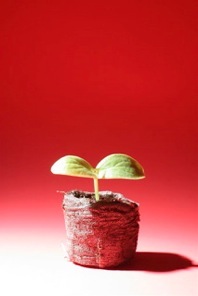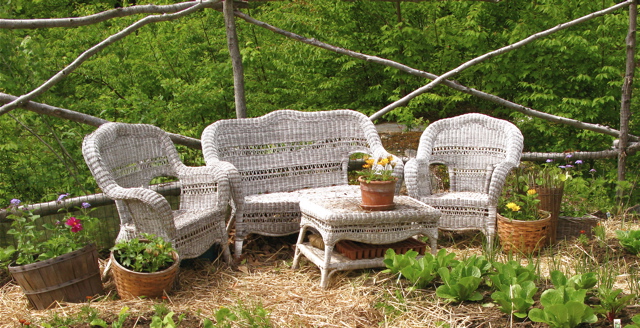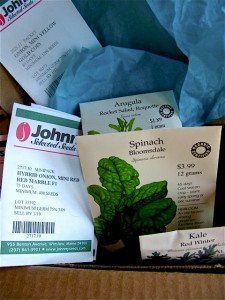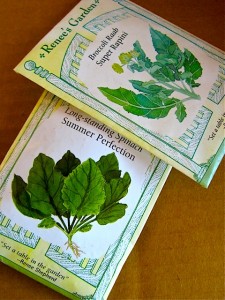Think Spring: It’s Time to Start Sowing Early Kitchen Garden Seeds …
The kitchen garden at Ferncliff, late May 2009 …
It’s always exciting when the first boxes of vegetable, herb and flower seed begin to arrive in the mail. I know, I know. I am a bit like a little kid – but I have to check the mail every day to see if there is something waiting for me in that big metal box at the foot of the hill. The Johnny’s package from Maine always arrives first, then Botanical Interests from Colorado, and then Renee’s Garden Seeds way out in California, (hello California, I miss you!). Â The first thing I do is open the box and just pour over all the pretty envelopes. I have to get that part out of my system. Then I begin grouping the seeds in order of sowing. Since I will start the onions, leeks and herbs in a week or so, those will be bundled together in the front. The cabbage, broccoli and other cold-hardy crops will be started in waves. Some will go into the hoop houses and some will be started indoors this year beneath grow lights. Oh, so much potential. I can’t wait.
First seed packets arriving …
There will be much to do and talk about in the coming weeks. For now, I just want to go over some very basic information for new gardeners, especially for those starting their own seeds for the first time. Many seed companies also have tutorials on their sites, and I recommend you visit those pages as well. The Vegetable Gardener’s Bible by Ed Smith is an excellent resource for new gardeners, and a good reference book for more experienced green-thumbs…
 Photo © Tim Geiss
Photo © Tim Geiss
1. Sort through your seeds: Check the back of the packets for planting information. Some seeds are best started indoors, (such as onions, leeks, tomatoes, peppers, etc), especially in cold climates, and some seeds are best direct-sown, (such as peas, beets, carrots, radish, etc). If you have left over seed from last fall, you can use those seed this spring. I have left over spinach and broccoli raab to use before I open the new packs later this year. Check expiration dates. You can and should try older seeds if you have them, but be aware that if your seeds haven’t been stored properly, (cool, dry, dark location), you may not have as much success with germination.
2. Gather free-draining containers and trays: You can buy starter cells, peat-pots or plastic cells online or at your local garden center if you like, but this isn’t absolutely necessary. Seeds can be started in empty milk and egg cartons, sliced up paper towel and toilet paper rolls, homemade newspaper pots, (more on this later), and recycled, (sterilized), six packs from garden centers. Starting seed need not be expensive or difficult. The most important thing is good drainage, so be sure to poke holes in whatever ‘pots’ you create from recycled materials. I absolutely encourage you to experiment with containers! I like to set my free draining pots in plastic or metal trays to catch water and provide moisture.
3. Purchase good quality, organic seed starting mix: It’s possible to make your own mix, of course, but if you are just starting out, I am going to suggest that you buy a good quality, well-drained  seed starting medium from a local garden center. This isn’t expensive, and starter soil is very important. Do not use regular potting soil, as it is too heavy, (doesn’t drain well), and will reduce your germination and success rate.
4. Time your starting: Look at the last frost date for your area and count the weeks back. If you live in New England, you will be starting things like onions, leeks and cabbage this month. If you live in a slightly warmer climate, you may be starting tomatoes and peppers this month. I like to use the Farmer’s Almanac online as a resource for last-frost date.
5. Get started with planting: Â Begin by filling your cells with moist starter mix. I like to moisten the mix first and then put it into the starter pots. This way, I won’t be washing the delicate seeds out when I add water. Read the seed packet to get the proper planting depth, especially if this is your first time starting seeds. I like to plant 2-3 seeds per cell, filling all the cells in my flats, and then I cover them, (but don’t smother, loosely cover above the soil), with clear plastic. You needn’t purchase special covers to do this, but it can be helpful. In cold, drafty homes a heating pad is very helpful to maintain the 70 degree temperature recommended for most seed germination. Â Some seeds will germinate in a matter of days, and some will take weeks, (again, check the back of your packets). Be sure to keep those cells moist, but not soggy.
6. Provide light: Once you see seeds germinating, you want to immediately place the trays beneath fluorescent/full-spectrum light bulbs. The light will need to be within a couple of inches of the seedlings, or the seedlings will grow long and spindly as they reach for the light. The grow-lights should be raised as the plants grow, keeping the light source very close. Many gardeners purchase special grow lights, but once again, this isn’t necessary. I know very successful home gardeners using shop lights or other home-built contraptions, but please be safe. Lights can be left on 24 hours, and because many fires start electrically, I encourage you to use caution.
7. Water: Again, keep the seedlings moist, but not soggy. By placing your seed containers in trays, as I mentioned above, you can water from the bottom by adding water to the tray, reducing the risk of water-logging and wash-outs as the seedlings grow.
8. Fertilize: When seedlings develop their first real leaves, as opposed to the little, itty bitty leaves you see when the plants emerge from the soil, you can begin giving the seedlings an organic starter fertilizer or weak fish-emulsion mix. Look for either of these products in a local garden center.
9. Provide air circulation: Two things will be necessary as plants grow. First, thin your seedlings. Look for the strongest seedling in each cell and then with clean, sharp scissors, cut off the one or two other seedlings right down to the soil line. Be careful, but be ruthless! This thinning will reduce competition and improve air-flow. And speaking of airflow, it may help to have a small fan nearby and run this for at least a few hours every day. Air circulation is very important for reducing the spread of fungus.
Whew. Well, that ought to get you started! I will continue with tips for transplanting and hardening off in another week or so. But for now… enjoy looking over and reading those beautiful packets and all the promise they hold. Get familiar with your seeds – it will make you a better gardener !
Some of my favorites from last fall: Renee’s Garden Seeds – Long Standing Spinach and Broccoli Raab…
***
All content in this article, (with noted exceptions), is © 2010 The Gardener’s Eden, all rights reserved.
***
20% off White Flower Farm Gift Certificates Over $50 for Valentine’s Day! Use Code AS309. Offer valid 1/30/10 to 2/14/10
Click Here!
***
***
One Reply to “Think Spring: It’s Time to Start Sowing Early Kitchen Garden Seeds …”
Comments are closed.




Thank you for another very informative article. I look forward to getting started, now that I know what I need to do. I was given stir fry seed packet for Christmas. It had those dirt cells that are supposed to expand in water. Every time I look in there it looks like there is mold on it and no seedlings. I’m going to dump those out and try again with good potting soil.